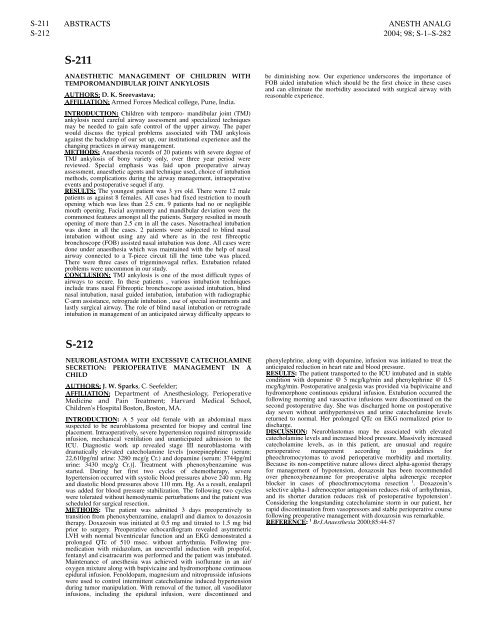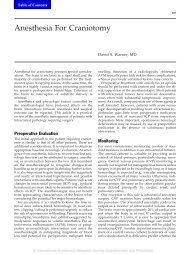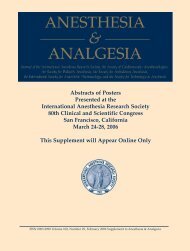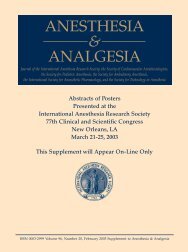ANESTHESIA & ANALGESIA - IARS
ANESTHESIA & ANALGESIA - IARS
ANESTHESIA & ANALGESIA - IARS
You also want an ePaper? Increase the reach of your titles
YUMPU automatically turns print PDFs into web optimized ePapers that Google loves.
S-211<br />
S-212<br />
ABSTRACTS ANESTH ANALG<br />
2004; 98; S-1–S-282<br />
S-211<br />
ANAESTHETIC MANAGEMENT OF CHILDREN WITH<br />
TEMPOROMANDIBULAR JOINT ANKYLOSIS<br />
AUTHORS: D. K. Sreevastava;<br />
AFFILIATION: Armed Forces Medical college, Pune, India.<br />
INTRODUCTION: Children with temporo- mandibular joint (TMJ)<br />
ankylosis need careful airway assessment and specialized techniques<br />
may be needed to gain safe control of the upper airway. The paper<br />
would discuss the typical problems associated with TMJ ankylosis<br />
against the backdrop of our set up, our institutional experience and the<br />
changing practices in airway management.<br />
METHODS: Anaesthesia records of 20 patients with severe degree of<br />
TMJ ankylosis of bony variety only, over three year period were<br />
reviewed. Special emphasis was laid upon preoperative airway<br />
assessment, anaesthetic agents and technique used, choice of intubation<br />
methods, complications during the airway management, intraoperative<br />
events and postoperative sequel if any.<br />
RESULTS: The youngest patient was 3 yrs old. There were 12 male<br />
patients as against 8 females. All cases had fixed restriction to mouth<br />
opening which was less than 2.5 cm. 9 patients had no or negligible<br />
mouth opening. Facial asymmetry and mandibular deviation were the<br />
commonest features amongst all the patients. Surgery resulted in mouth<br />
opening of more than 2.5 cm in all the cases. Nasotracheal intubation<br />
was done in all the cases. 2 patients were subjected to blind nasal<br />
intubation without using any aid where as in the rest fibreoptic<br />
bronchoscope (FOB) assisted nasal intubation was done. All cases were<br />
done under anaesthesia which was maintained with the help of nasal<br />
airway connected to a T-piece circuit till the time tube was placed.<br />
There were three cases of trigeminovagal reflex. Extubation related<br />
problems were uncommon in our study.<br />
CONCLUSION: TMJ ankylosis is one of the most difficult types of<br />
airways to secure. In these patients , various intubation techniques<br />
include trans nasal Fibreoptic bronchoscope assisted intubation, blind<br />
nasal intubation, nasal guided intubation, intubation with radiographic<br />
C-arm assistance, retrograde intubation , use of special instruments and<br />
lastly surgical airway. The role of blind nasal intubation or retrograde<br />
intubation in management of an anticipated airway difficulty appears to<br />
S-212<br />
NEUROBLASTOMA WITH EXCESSIVE CATECHOLAMINE<br />
SECRETION: PERIOPERATIVE MANAGEMENT IN A<br />
CHILD<br />
AUTHORS: J. W. Sparks, C. Seefelder;<br />
AFFILIATION: Department of Anesthesiology, Perioperative<br />
Medicine and Pain Treatment; Harvard Medical School,<br />
Children's Hospital Boston, Boston, MA.<br />
INTRODUCTION: A 5 year old female with an abdominal mass<br />
suspected to be neuroblastoma presented for biopsy and central line<br />
placement. Intraoperatively, severe hypertension required nitroprusside<br />
infusion, mechanical ventilation and unanticipated admission to the<br />
ICU. Diagnostic work up revealed stage III neuroblastoma with<br />
dramatically elevated catecholamine levels [norepinephrine (serum:<br />
22,610pg/ml urine: 3280 mcg/g Cr.) and dopamine (serum: 3744pg/ml<br />
urine: 3430 mcg/g Cr.)]. Treatment with phenoxybenzamine was<br />
started. During her first two cycles of chemotherapy, severe<br />
hypertension occurred with systolic blood pressures above 240 mm. Hg<br />
and diastolic blood pressures above 110 mm. Hg. As a result, enalapril<br />
was added for blood pressure stabilization. The following two cycles<br />
were tolerated without hemodynamic perturbations and the patient was<br />
scheduled for surgical resection.<br />
METHODS: The patient was admitted 3 days preoperatively to<br />
transition from phenoxybenzamine, enalapril and diamox to doxazosin<br />
therapy. Doxazosin was initiated at 0.5 mg and titrated to 1.5 mg bid<br />
prior to surgery. Preoperative echocardiogram revealed asymmetric<br />
LVH with normal biventricular function and an EKG demonstrated a<br />
prolonged QTc of 510 msec. without arrhythmia. Following premedication<br />
with midazolam, an uneventful induction with propofol,<br />
fentanyl and cisatracurim was performed and the patient was intubated.<br />
Maintenance of anesthesia was achieved with isoflurane in an air/<br />
oxygen mixture along with bupivicaine and hydromorphone continuous<br />
epidural infusion. Fenoldopam, magnesium and nitroprusside infusions<br />
were used to control intermittent catecholamine induced hypertension<br />
during tumor manipulation. With removal of the tumor, all vasodilator<br />
infusions, including the epidural infusion, were discontinued and<br />
be diminishing now. Our experience underscores the importance of<br />
FOB aided intubation which should be the first choice in these cases<br />
and can eliminate the morbidity associated with surgical airway with<br />
reasonable experience.<br />
phenylephrine, along with dopamine, infusion was initiated to treat the<br />
anticipated reduction in heart rate and blood pressure.<br />
RESULTS: The patient transported to the ICU intubated and in stable<br />
condition with dopamine @ 5 mcg/kg/min and phenylephrine @ 0.5<br />
mcg/kg/min. Postoperative analgesia was provided via bupivicaine and<br />
hydromorphone continuous epidural infusion. Extubation occurred the<br />
following morning and vasoactive infusions were discontinued on the<br />
second postoperative day. She was discharged home on postoperative<br />
day seven without antihypertensives and urine catecholamine levels<br />
returned to normal. Her prolonged QTc on EKG normalized prior to<br />
discharge.<br />
DISCUSSION: Neuroblastomas may be associated with elevated<br />
catecholamine levels and increased blood pressure. Massively increased<br />
catecholamine levels, as in this patient, are unusual and require<br />
perioperative management according to guidelines for<br />
pheochromocytomas to avoid perioperative morbidity and mortality.<br />
Because its non-competitive nature allows direct alpha-agonist therapy<br />
for management of hypotension, doxazosin has been recommended<br />
over phenoxybenzamine for preoperative alpha adrenergic receptor<br />
blocker in cases of pheochromocytoma resection 1 . Doxazosin’s<br />
selective alpha-1 adrenoceptor antagonism reduces risk of arrhythmias,<br />
and its shorter duration reduces risk of postoperative hypotension 1 .<br />
Considering the longstanding catecholamine storm in our patient, her<br />
rapid discontinuation from vasopressors and stable perioperative course<br />
following preoperative management with doxazosin was remarkable.<br />
REFERENCE: 1 BrJ.Anaesthesia 2000;85:44-57





